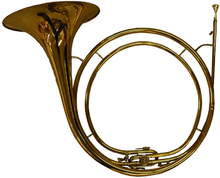Parforce horn
The parforce horn is a brass instrument that originally served as a signaling instrument for parforce hunting . It is a precursor to the French horn .
Types
The parforce horn consists of an almost cylindrical tube made of brass , which ends conically in a protruding lintel ( bell ). The original horn for hunting only had one turn; it was only built with multiple windings for use in an orchestra. For use in the context of hunting customs, there is now also a multi-wind instrument with a reduced coil diameter that is easier to handle than the original horn. In modern instruments, the winding (s) are often wrapped with a leather strap. This increases the grip and stability of the instrument and prevents corrosion of the metal from hand perspiration.
use
Parforce horns are primarily used in hunting customs to blow hunting signals . The large curl allows you to put your head and arm through and carry the horn over your shoulder. This leaves both hands free for riding.
Some romantic operas, such as Der Freischütz by Carl Maria von Weber in the “Jägerchor” and Joseph Haydn's oratorio Die Jahreszeiten rely on imitations of these instruments for artistic effect. The melody for the Freischütz can be blown with the 6th to 14th notes of the natural scale.
Parforce horns are now also blown in concert form in so-called wind corps, the instruments in Eb or Eb / B-flat usually alone, with four-part movements predominating. The parforce horn in Eb sounds only a semitone higher than the trompe de chasse tuned in D and can be overblown just as well as this. Therefore, the pieces composed for the trompe de chasse can also be played on parforce horns in E flat. This is facilitated by the fact that higher quality instruments, especially those without a switch valve, now have a dynamic range that is as large as that of the trompe de chasse.
Parforce horns in Bb and those in Eb / Bb with the switch valve locked in B-position are also blown together with Fürst-Pless horns , with four-part (2 Fürst-Pless-Horn parts, 2 Parforcehorn parts) and six-part (4 Fürst- Pless horn parts, 2 parforce horn parts) dominate movements. With unison hunting signals, the Parforce horns play an octave lower than the Fürst-Pless horns.
The interaction with other instruments is rare. Occasionally, parforce horns are used together with the organ at a Hubertus Mass, for example . The instrument is also used in fanfare parades .
Moods, posture, playing technique
The basic tuning is in Eb, Bb or with a valve switchable between Eb or B. The instrument in Bb sounds a fifth higher than the one in Eb. By blowing natural tones , melodies and, as a characteristic two-part tone sequence, the so-called horn fifths can be played. At least 12 natural tones can be played on the instrument in Bb, and at least 16. Parforce horns are transposing instruments ; notation is always in C major (i.e. without an accidental) in the treble clef . The Parforce horn in Bb is also made in a version with three valves (the valves act like a trumpet). In France, instead of the parforce horn, the trompe de chasse, which has the key D, is blown.
The instrument is held with the right hand, the left hand may only have a light support function. Contrary to the modern French horn posture, the right hand is not placed in the falls, the instrument is usually played openly. The stuffing , i.e. the deep insertion of the hand into the lintels, which causes the blown tone to sound up to a whole tone lower, is occasionally used to realize openly unplayable tones. Stuffed tones sound much darker than open tones. With the Eb / Bb instrument, some of these notes can also be realized by switching from Eb to Bb when the piece itself is in Eb. However, this method is controversial for pieces composed for non-switchable Parforce horns, as the tonal difference between open and stuffed tones is part of the character of these pieces.
Mouthpiece
The originally used Parforce horn mouthpiece is funnel-shaped and has an extremely narrow rim. This creates a very penetrating sound that carries very far in the forest. When used originally, it is not a question of "romantic sound beauty", but rather large volume. In the past, therefore, the blowers cut open the skin of their lips and left them scarred . The hardened skin prevented excessive pressure on the mouthpiece from squeezing the lip muscles . However, this "blaring" is a thing of the past; dynamics also play an important role in modern interpretation. (See next section) Modern parforce horn mouthpieces are basically built like French horn mouthpieces, a small cup favors blowing in high registers, a large cup that in lower registers.
literature
- Josef Pöschl: Hunting Music: Continuity and Development in European History. H. Schneider, 1997 ( online )
- Monika Lustig: Hunting and French horns: history and musical use. Wissner, 2006 ( online )
- Volker Giel: JW Goethe - Briefe, Volume 6: Beginning of 1785 - September 3, 1786. Walter de Gruyter, 2010, p. 397 ( online )
- Gisela Csiba, József Csiba: The brass instruments in Johann Sebastian Bach's works. Merseburger, 1994 ( online )
Web links
- Parforce horn in the glossary on volxmusik.de (see under "P")
- The different types of hunting horns on parforcehornmusik.de



